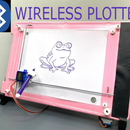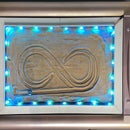Introduction: PVC Abacus
The abacus, also called a counting frame, is a calculating tool which has been used since ancient times. It consists of rows of movable beads, or similar objects, strung on a wire. They represent digits. One of the two numbers is set up, and the beads are manipulated to perform an operation such as addition, or even a square or cubic root.
The soroban (counting tray) is an abacus developed in Japan. It is derived from the ancient Chinese suanpan, imported to Japan in the 14th century. Like the suanpan, the soroban is still used today, despite the proliferation of practical and affordable pocket electronic calculators.
The soroban is composed of an odd number of columns or rods, each having beads: one separate bead having a value of five, called go-dama ("five-bead") and four beads each having a value of one, called ichi-dama ("one-bead"). Each set of beads of each rod is divided by a bar known as a reckoning bar. The number and size of beads in each rod make a standard-sized 13-rod soroban much less bulky than a standard-sized suanpan of similar expressive power. The number of rods in a soroban is always odd and never fewer than seven. (Source:- Wikipedia)
This PVC Abacus consists of seven rods and 35 beads.
Step 1: Materials and Tools
Materials
- PVC pipe (2 meters long)
- Elbow L-type (4pcs)
- Elbow T-type (2pcs)
- Paint (black and sky blue)
- Pencils (7pcs)
- Flexible PVC pipe (0.6 meters long, 14.24mm external dia.)
- Rubber pipe (0.6 meters long, 10.27mm external dia.)
Tools
- Mini hacksaw
- Steel 2nd cut Flat file
- Soldering iron
- Measuring tape/ scale
- Mallet Hammer
- Vernier Caliper Digital
- Paper cutting blade
Step 2: Construction of Frame
For the frame of the Abacus, we need to cut PVC pipe according to following dimensions:
1. PVC pipe of length = 238 mm (total =3)
2. PVC pipe of length = 70 mm (total =2)
3. PVC pipe of length = 30 mm (total =2)
Apart from the above parts, we need 4 L-type elbows and 2 T-type elbows.
All these parts constitute the frame of PVC Abacus.
To cut PVC pipes, I used a Mini Hacksaw having number of 32 teeth per inch.
For making holes on PVC pipe, I used soldering iron. Total 7 holes are made on one side of two PVC pipes having length = 238mm, each hole size is 7.2 mm and the distance between each hole is 20mm.
On one PVC pipe (238 mm), which act as reckoning bar, holes are made on both sides (7 holes each side).
Now paint all these parts with black paint.
Step 3: Basic Structure
Step 4: Beads
The most important part of Abacus is beads. These beads should slide on Rod properly and have some grip.
These beads also made with PVC pipe. Total 35 beads are required. 5 bead for each rod.
Cut a PVC pipe into 35 pieces of length 12mm with the help of mini hacksaw. Steel file was used to remove extra material or burr.
All 35 PVC beads are painted with sky blue paint.
As the internal diameter of PVC bead is 14.24mm and the diameter of the pencil is 7mm. To fill extra area and to make bead, I used a flexible PVC pipe and a rubber pipe inside it.
The length of the Flexible PVC pipe and the rubber pipe is slightly larger than the length of PVC bead to provide some space between two neighboring beads.
This rubber pipe provides some grip to the bead on the Rod.
Insert the rubber pipe in flexible PVC pipe and this flexible pipe into PVC bead as shown in image.The final size of each bead is 16.50mm. All 35 beads are prepared in this manner.
Step 5: Rod/column
The pencils (length= 178mm, diameter= 7mm) act as the Rod/column of this Abacus. We need 7 pencils for this Abacus.
Step 6: Assemble All Parts
Assemble all frame parts such that the holes of all three Rods aligned. Attach the elbows on the corners and the sides of the frame.
Insert a pencil with beads one by one through the holes. Above reckoning bar (middle bar) insert one bead and below it insert four beads. Take the help of images.
Make three white dots on the first, third and seventh bar having its own significance.
After inserting all pencils, join the bottom PVC pipe of the frame.
Now that’s all. The PVC Abacus is ready to use.
Step 7: Calculation/Working
Example 1:- Representation of digits 22 on the PVC Abacus.
Just slide two beads on the ones and tens place to the reckoning bar.
Example 2:- Addition of two numbers 43 and 51
Input your first number by entering 43 on the abacus by pushing up three beads in the ones place, four in the tens place. Now enter the second number by pushing tens bead (value=5) above to Reckoning bar.
Count your beads to get the answer :- 43+51 = 94
You can find how to use it following this link:-
http://m.wikihow.com/Use-an-Abacus
Thanks for watching.





